Once again we went to le Musée Guimet and burned out before we could do justice to the permanent collection, which is varied and extensive, comprising art in many forms from across Asia. The current exposition is titled Du Nô à Mata Hari: 2000 ans de théâtre en Asie (From Noh to Mata Hari: 2000 years of theatre in Asia). An associated exposition is called Japon, images d’acteurs: estampes du Kabuki au 18e siècle (Japan, images of actors: prints of the Kabuki of the 18th century).*
Here are a few samples of what is in the temporary show.
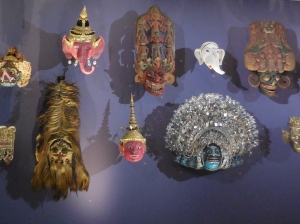

>> A selection of masks used in South Asian performances.
>> Indian cinema draws on the same epics depicted in traditional theatre. This is a portable projector that could be set up to show movies in even the smallest and most remote villages: 20th c., wood, metal, glass, paint.
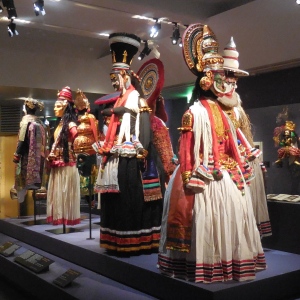

>> Costumes made of wood, textiles, mirrors, paper, and feathers, Kerala, India, 1970, for productions about Ravana, the demon with 10 heads, king of Lanka, and about Hanuman, the general of the army of monkeys.
>> This is a detail of a cloth made in Bali at the turn of the 19-20th c., depicting Le Barattage de la Mer de Lait (The Churning of the Sea of Milk), a scene from the Mahabharata. I wonder if it turned into ghee, rather than butter.

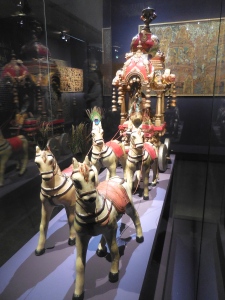
>> Make-up on a kathakali actor, Kerala, India, 1971. A special seed is rubbed on the whites of the eyes to make them red: how’s that for dedication to one’s art?! [The large photograph by Suzanne Held is beautifully sharp and clear.]
>> Krishna driving the chariot of Arjuna to the battle of Kurukshetra, where he sees family and friends on both sides, making him reluctant to join in the fighting. Krishna points out that Arjuna has no choice: he must follow his destiny. Terra cotta, wood, and wire, c.1930.
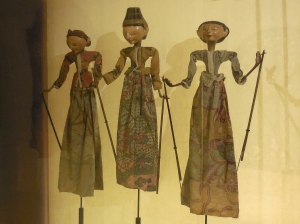
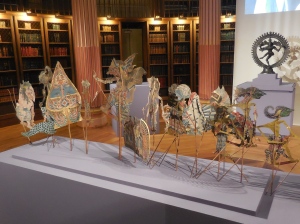
>> Female Wyang guluk rod puppets from Java, Indonesia, 20th c.: wood, paint, cotton cloth.
>> Indonesian shadow puppets displayed in the library.
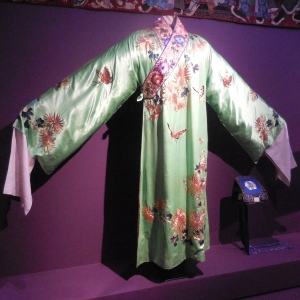

>> Peking Opera costume, early 19th c.
>> This Peking Opera costume with a pheasant feather headdress was made before 1966. Both somehow survived the Cultural Revolution.
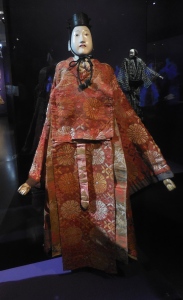
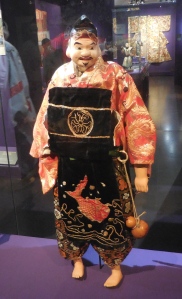
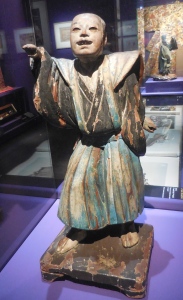
>> Two Japanese Bunraku puppets, ±75cm/30″ high.
>> Small, painted wood sculpture of a Japanese Noh actor, carved during the Momoyama period (1573-1603).
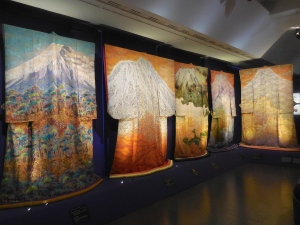
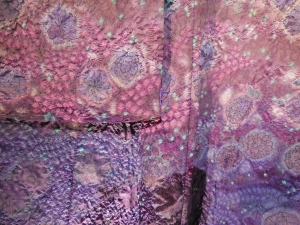
>> Kimonos by Itchiku Kubota (1917-2003). They form both the costumes and the scenery and are especially well suited to Noh dramas. At age 20, Kubota found a fragment of a 16th c. kimono made in the Tsujigahana technique, which used tie and dye, stitching, and painting. He devoted his career to developing a modern version of the technique, shown in detail on the right. The dots of colour are little puffs.
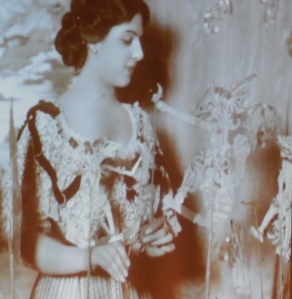
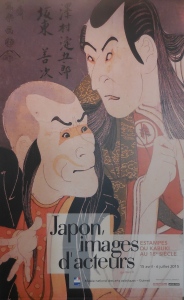
>> Margaretha Geertruida “Grietje” Zelle (1876-1917) was a beautiful and graceful Dutch dancer and courtesan. In 1905 Émile Guimet invited her to his mansion, where she mesmerized a group of distinguished orientalists with her erotic Brahmin dances, performed in the round library, which had been converted into a “Hindu temple” for the occasion. M. Guimet suggested that she change her name to Mata Hari. She played up the mystique, scandalizing and fascinating many people for more than 10 years. There is some question as to whether she simply got carried away with her image of herself as femme fatale or if she did in fact act as a spy against France, the crime for which she was executed by firing squad in 1917. In this 1905 photo she is admiring the same shadow puppets as are shown above.
>> Photos were not allowed of the Kabuki prints, so I can include only the poster of it.
(For more information, search “guimet paris.”)
——————–
*The former is on until 31 August 2015, the latter only until 6 July 2015.

The Wyang rod puppets speak to me!